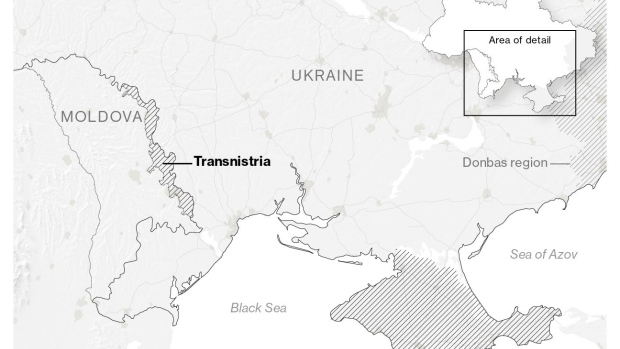May 8, 2022
Ukraine’s Tiny Neighbor Suffers Economic Fallout From the War
, Bloomberg News

(Bloomberg) -- The Russian invasion of Ukraine has spurred a rush of loans to help tiny Moldova defray the economic hit from the war raging next door. Things are so perilous that the International Monetary Fund is now calling on nations to send cash.
The conflict is piling pressure on the ex-Soviet nation, just as it started trying to fix graft and other structural problems.
Moldova is in some ways still caught between two worlds. It hopes to join the European Union but is still tethered to Moscow by energy. Tensions are also rising in the pro-Russian separatist territory of Transnistria, raising concerns Moldova may get pulled into a broader conflict.
The war in Ukraine could potentially push Moldova to make a decisive break with the past. The government has fast-tracked a bid to join the EU and, since February, has the technical ability to switch from Russian to European electricity and gas grids.
Yet with annual inflation at 22%, growth crashing from a post-Covid surge of 14% in 2021 to a projected 0.3% this year, and exports and remittances disrupted, the conflict could yet destabilize the nation of 2.6 million.
Putin’s War Brings Risks to Moldova and Its Pro-Moscow Enclave
The risk, according to Rodgers Chawani, the IMF’s resident representative in Moldova, is that so much is borrowed to rescue the country from external shocks that none is left for domestic reforms.
“At what point will they be able to focus on their own agenda?” Chawani asked, worrying that as institutions such as the IMF can only make loans, the accumulating debt will consume future revenue that should have been spent on development.
“The problem is that they could become overburdened,” he said, speaking at his office in Chisinau, Moldova’s capital. “That’s why we’re asking bilateral donors to offer more grants.”
Before the war, the IMF projected that Moldova’s ratio of public debt to GDP would hit 40% in 2022, from 27.9% in 2019. The fund assesses anything over 45% as unsustainable for Moldova, according to Chawani.
The IMF alone has pledged about $815 million in budgetary support since December (some is awaiting final approval), as it tries to fill an estimated shortfall of $1.7 billion — around 14% of the economy — with much of that down to war fallout.
Another $300 million facility for Moldova to buy stored natural gas awaits approval from the European Bank for Reconstruction and Development’s board, and that’s before hundreds of millions more in infrastructure and other support from allies and international institutions. Last month, the EU offered 150 million euros.
The money also reflects a sense of faith in the current government.
As recently as 2018, the EU suspended aid to Moldova, exhausted by a seemingly perpetual carousel of broken reform pledges and spectacular money-laundering scandals.
A year later, a government led by Prime Minister — now President — Maia Sandu came to power pledging to improve governance, clean out revenue-sapping state enterprises and overhaul a chronically politicized judiciary. Those efforts were set back by her temporary removal, followed by Covid-19, soaring natural gas prices, and now the costs of the war in Ukraine, including the need to support 450,000 refugees, 95,000 of whom decided to stay.
Another war cost is to remittances, which brought the economy just under $1.5 billion in 2020, more than 10% of GDP. Already falling, the share sent home by Moldovans working in Russia, Ukraine and Belarus looks set to collapse. The same will be true for trade with those countries.
The good news, says Giorgi Shagidze, chief executive at Moldova-Agroindbank SA, or MAIB, is the banking sector — in collapse in 2015 — is stronger, the central bank has adequate reserves and consumers are not overleveraged. “These numbers are not scary,” he said.
“The scary part is what happens to deposits and inward investment, and to outflows as a result of the conflict,” said Shagidze. Hundreds of thousands of Moldovans have Romanian passports and can take their money across the border to the EU member if they feel unsafe in Chisinau. MAIB is the country’s largest bank.
‘A Bet on the War’: Vineyard Exposes Risks in Front-Line Moldova
Potentially the weakest point for Moldova’s economy is its long running energy dependence on a combination of Russia’s Gazprom PJSC and Transnistria, where Soviet-era planners concentrated most of the republic’s industry, including a gas fired power station.
Until recently, Moldova had no alternative. A gas interconnector with Romania opened in October, and while Moldova used that to buy a little gas on Europe’s spot market, the price was 10 times what it paid Gazprom during Covid, according to State Secretary for Infrastructure and Regional Development, Constantin Borosan. Moldova signed a five-year gas contract with Gazprom in October.
Why Moldova’s Transnistria Region Matters to Putin
With refugees added to the population, consumption is up. And gas bought from Russia under contract remains far cheaper than on the European spot market.
Moldova also now has a synchronized connection to Ukraine’s electricity grid. Still, Borosan said he just extended an expired contract with Transnistria’s power company for a month, because its price was half that offered by Ukraine.
“Yes there is solidarity” with Ukraine, he said, but “how can we explain to our people that we are buying more expensive power. Who benefits?”
Angela Sax, head of the EBRD’s Moldova mission, sees an opportunity lost. “They’ve been in rolling crises running straight from pandemic to energy,” Sax said, while praising the reformist tilt of the government. “The window of opportunity is not that long.’
©2022 Bloomberg L.P.






